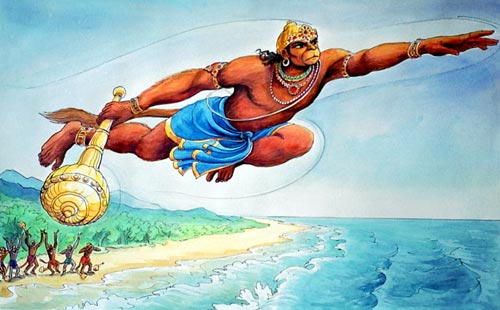
My ex-manager and a really good friend of mine has written this post about corporate and real life lessons that we all can learn from Hanuman and his exploits in the great epic Ramayana.
Given that the monkey god is an all-time, all-weather favorite of all Indians, I am sure that this post will resonate with all the readers.
================
As my elder girl is named after Hanuman’s mother (Anjana), Hanuman somehow seems less a God and more a family member to me! Regardless of whether you consider Hanuman to be real or a character from a story, there are some endearing qualities about Hanuman that deserve our attention.
Sundara – Hanuman’s birth name was Sundara. Can a monkey face be beautiful? Beauty truly lies in the eyes of the beholder. Every one of us is beautiful to our mother, our spouse and our children. Don’t ever judge a person by his or her looks.
Guru Bakthi – Hanuman’s guru was Surya. When Hanuman learnt all that was to be learnt, he duly requested Surya to name his Guru Dakshina (Fee). Surya refused initially citing that teaching Hanuman was a pleasure by itself. When Hanuman insisted, Surya asked Hanuman to be Sugriva’s minister. Hanuman happily obliged. Education or mentorship can never be a commercial transaction. Knowledge can be acquired only if it joyfully imparted and respectfully accepted. Treat your managers with respect. They may still have something to teach you.
Humility – Hanuman carried his titles & achievements lightly. I have seen too many of our associates attitude take a turn for the worse after a promotion and a corner cabin.
Be Inspired – Hanuman was cursed by a Rishi that he will not remember his strength. When the ocean needed to be crossed, Jambavan had to remind Hanuman about his powers before Hanuman took the leap. Know who your Jambavan is. He is your well-wisher who knows more about you than you.
Differentiate – While crossing the ocean, Hanuman encountered obstacles from Mainaka, Surasa and Simhika. Yet, he tackled each one differently. Mainaka the mountain was a well-wisher who just wanted to be hospitable to Hanuman. Knowing that he will be delayed if stayed too long, Hanuman respectfully took leave from Mainaka and proceeded with his journey.
Hanuman met Surasa next. Surasa had previously obtained a boon that any living thing crossing the ocean would be food for her stomach. Surasa sought to swallow Hanuman. Hanuman realized that Surasa was just doing her dharma (duty). Without wasting any moment, Hanuman increased his size. Surasa opened her mouth wider. Suddenly, Hanuman shrunk his size, quickly entered Surasa’s mouth and exited before Surasa could react. Hanuman had done what Surasa had asked for and Surasa now sportingly let him go.
After this, a Rakshashi called Simhika caught hold of Hanuman’s shadow and tried to eat him. Hanuman realized the threat from Simhika and killed her right away before continuing to Lanka.
Learn to differentiate a friend, a professional rival and an enemy. Don’t behave in the same manner with everyone!
Kanden Sithai (Saw Sita!) – Hanuman spoke to the point. Knowing that Rama was anxiously waiting for news about Sita, Hanuman conveyed to Rama the news about Sita succinctly. Too many of us beat around the bush. Learn to write crisp, easy to understand e-mails!
We can read (and treat) Ramayana as a story or we can treat it as history. The word ‘Ramayana’ means Rama’s journey (‘ayana’). Treat Ramayana as Rama’s blog posts. The people Rama encountered, the places he went and the things he did, have a lot to teach us. Ramayana is incomplete without Hanuman.
I read Lesley Hazleton’s book – ‘The First Muslim’ which is on Prophet Muhammad’s life. Though the word – ‘Jihad’ has so many negative connotations today, the true meaning of ‘Jihad’ as meant in the Quran is ‘striving’! The first person to have realized Prophet Muhammad’s divinity was a Christian monk! Religions have more in common than we think.
Don’t mistake the messenger for the message!
None of what I have tried to explain above is my own original thought. I am just trying to make sense of the world around during my ‘ayana’. 🙂
=============
Although I enjoyed the whole post quite a bit, I personally enjoyed the few paragraphs about the tactics that Hanuman used to overcome the various obstacles in his flight to Lanka. There are just so many lessons that all of us can learn from those few paragraphs, which the author has quite succinctly summarized with one word – differentiate.
That word, used in this context, is loaded with so much gravitas and meaning, isn’t it.





